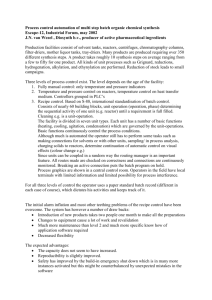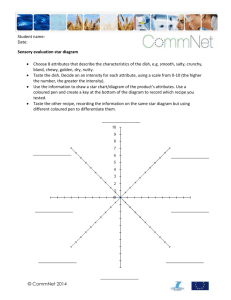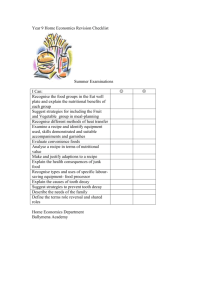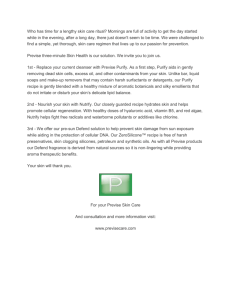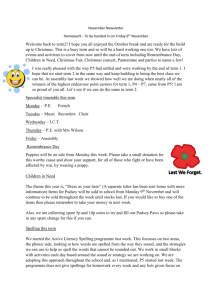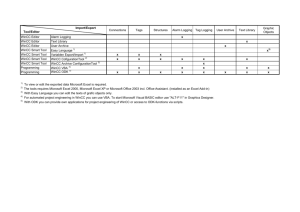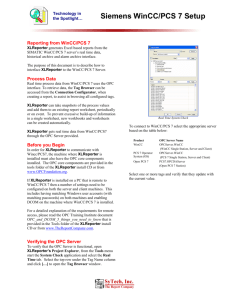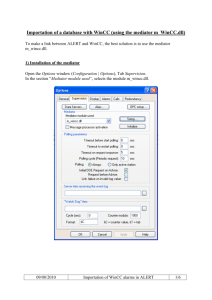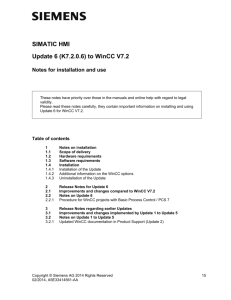6 Data acquisition 6.1 Data acquisition with Simatic WinCC
advertisement
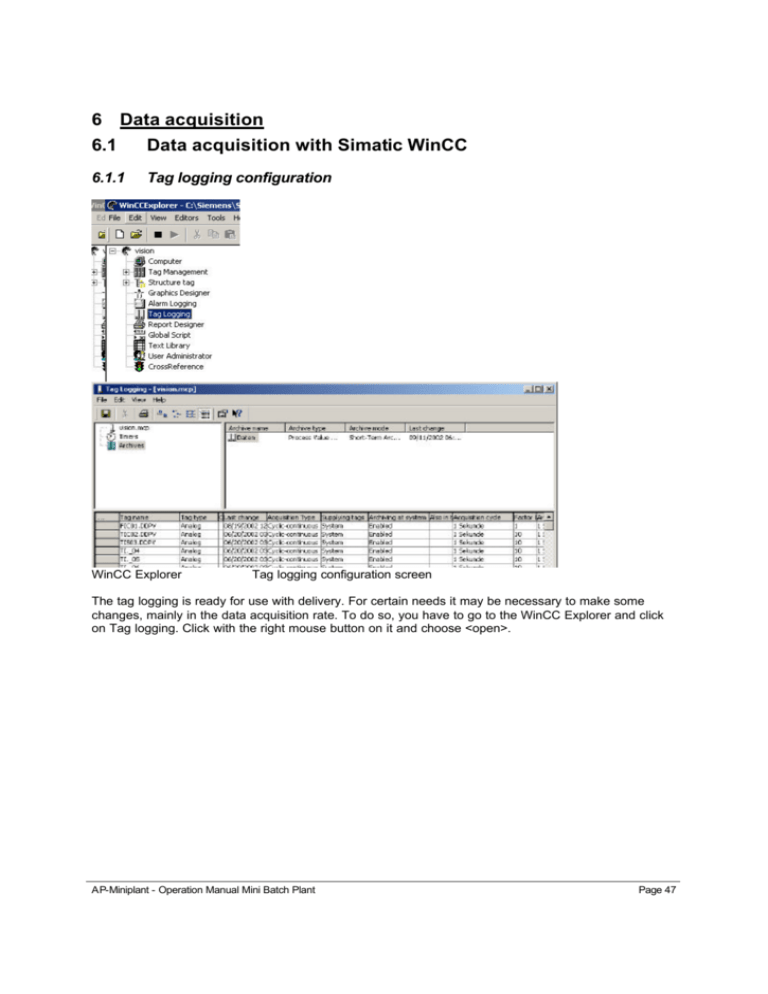
6 Data acquisition 6.1 Data acquisition with Simatic WinCC 6.1.1 Tag logging configuration WinCC Explorer Tag logging configuration screen The tag logging is ready for use with delivery. For certain needs it may be necessary to make some changes, mainly in the data acquisition rate. To do so, you have to go to the WinCC Explorer and click on Tag logging. Click with the right mouse button on it and choose <open>. AP-Miniplant - Operation Manual Mini Batch Plant Page 47 IMPORTANT: With the WinCC Runtime license you get the right to do 1-hour configuration. After this hour you will be asked to save your changes. To proceed, you will have to close and restart the WinCC Explorer. Tag logging configuration screen will open. If you select the properties of the „Daten“ archive and open the „Archive Parameters“ register, you find top right the number of entries in your archive. This is the number of values stored in the archive before new values will override them. You should not select a value > 65000 if you want to use the data in Microsoft Excel. Under this value you find the number of byte/entry. This multiplied by the number of entries will be the size needed on hard disc. ATTENTION: Archive Parameters. Old values will be erased by new ones after the number of entries is reached. For the tags you can determine the cycle time for each value separately. It is recommended to use quick rates only for values where you expect quick changes. There is a difference between acquisition of the system and the archiving. Under the point „Archiving/Display“ you can enter a factor from how many actual values there should be made one stored value. In the second register „Parameters“ you can enter the way how the stored value shall be made from the actual values. Standard is „Mean value“ here. Minimum acquisition and archiving time of this system is 1 Second. Archive tag, name and cycle time AP-Miniplant - Operation Manual Mini Batch Plant Parameters for archive variable Page 48 6.1.2 Using the stored data Data will be stored in the project path. Standard for all systems is: [Projektpfad]\wincproj\[Projektdateiname]\PDE\[Prozesswertarchiv] \[Variablenname]. For your system when delivered the path is: C:\Siemens\Step7\S7proj\P377\wincproj\vision\PDE\Daten\TIC01.DDPV.DBF Where the latter is the tag name followed by .DBF for the dbase file. This file can only be opened with write protect. This file stores the data in a ring buffer, that means that oldest data is deleted first when the buffer is full. IMPORTANT Always work with a copy of the original data. Save it as an *.xls file Right click on the value you need and then select open with -> Microsoft Excel for Windows. Excel File with data of TIC01, reactor temperature th th To get useful Time information from the first column apply the following strings to the 4 to 6 column, the example is for row 2: =CONCATENATE(MID(RC[-3],7,2),".",MID(RC[-3],5,2),".",MID(RC[-3],1,4)) =CONCATENATE(MID(RC[-4],9,2),":",MID(RC[-4],11,2),":",MID(RC[-4],13,2),",",MID(RC[-4],15,3)) =SECOND(RC[-1])+MINUTE(RC[-1])*60+HOUR(RC[-1])*3600 The functions do the following: Extract a date from column 1 Extract a time from column 1 Calculate the time in seconds from 0 a clock. These 3 functions in row 2 can be copied to all the other rows. You can mark the complete worksheet clicking to left in the corner and apply sort on the first row. Then you can search for the time interval you are looking for. AP-Miniplant - Operation Manual Mini Batch Plant Page 49 Excel file after adding the functions in column 4, 5 and 6. You can also use WinCC report system to do this job, but it is not flexible enough for research plants. 6.2 Data acquisition with the recipe system Recipe data will be filed during a recipe in the table data in the recipe workbook recipe.xls. After the recipe they will be filed with the name of the experiment and run in the path „C:\Siemens\Step7\S7proj\P375\Rezeptsteuerung\<Operatorname>\Data“. Where <Operatorname> is the name of the operator. The path shown above must exist. It will not be created automatically. It is necessary that the name of each data file is unique. The system does not allow to start the recipe before it has a unique number. To create the file name, the system uses project, experiment and run number. These 3 numbers, separated with underlines “_”, will form the file name. If you want to do data acquisition during the recipe, you will have to chose the data acquisition active click box. The following settings can be changed in the data table of the recipe.xls workbook: Headlines in the „Data“-worksheet. Diagram names can be changed in row 2 beginning from column 4. The colors are used to combine variables with diagrams. All variable names in row 300 which have the same background color as the one in row 2 with the Diagram name, are shown in this diagram. AP-Miniplant - Operation Manual Mini Batch Plant Page 50 In row 299 above the text names are situated which belong to the variables beneath it. Is one of the text names printed fat, it will be shown in the variable table or the experiment. The relevant data is in different lines. In line 100 the variables are defined for the data collected every time the step changes. The data for the sample starts in line 199. Line 300 the variable names define the cyclic data, which is written to this table in 5 s cycle time. The variable name must be written exactly the same way it is in WinCC. The connection, here S7P/ for process variables, must precede the name. To show a variable in the table which gives an reduced overview about the experiment, the name in the line 299 must be in bold letters. IMPORTANT: Changes in the table „data“ in the recipe.xls refer to all the following Experiments with recipe. Old experiments are not affected. AP-Miniplant - Operation Manual Mini Batch Plant Page 51 6.2.1 Working with data After pressing the <data> button, you will see this window. On the left side you see your experiments (empty!). You can use the predefined report or make your own reports using MS-Excel functionality. The first button will send the report to a printer, the second one to the screen. In the second case you have to go through the screens closing the active one with <close>. First page of the protocol, press <close> to proceed, you will get a table of values and after that some predefined diagrams. You always have to proceed with the <close> button. Manual data input allows the manual change of the header data. <Back to recipe definition> switches to recipe input menu <Close all open windows> closes the open Experiment *.xls-files <Rebuild curves> will rebuild the x-t-Diagrams or the data <Excel> will stop this program and give you access to Excel. AP-Miniplant - Operation Manual Mini Batch Plant Page 52

